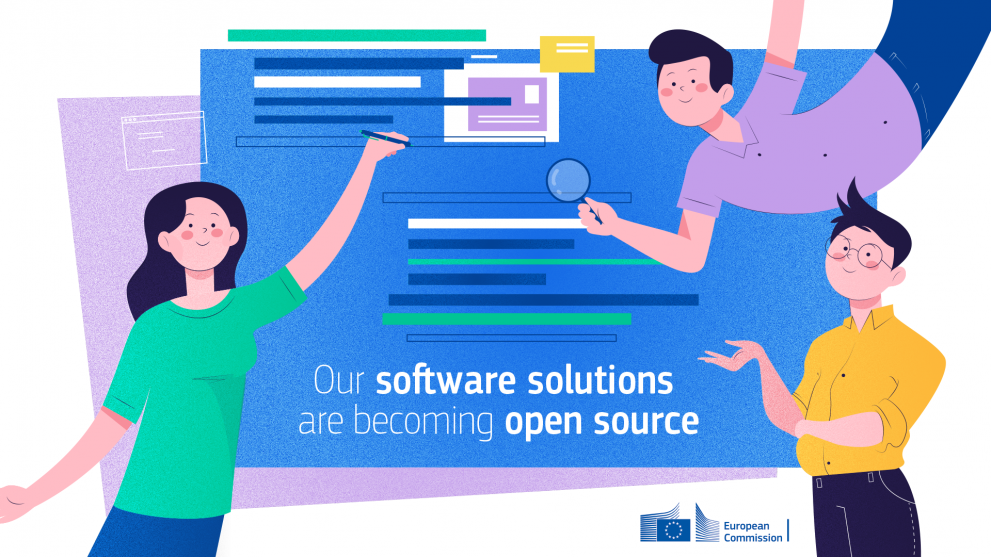
Today the Commission has adopted new rules that make open source licensing of its own software the default whenever this could benefit citizens, companies or other public services.
The Joint Research Centre played a key role in initiating these changes.
A recent study showed that investment in open source leads on average to four times higher returns. Up to now, open source licensing of a Commission software required a Commission decision and a lengthy process. Thanks to this decision, Commission services will be able to publish their software source code in much shorter time and with less paperwork.
The JRC, as one of the main sources of software development in the Commission, drafted the new in-house rules on open source licensing in close cooperation with the Directorate-General for Informatics.
Commissioner for Budget and Administration, Johannes Hahn, said: “Open source offers great advantages in a domain where the EU can have a leading role. The new rules will increase transparency and help the Commission, as well as citizens, companies and public services across Europe, benefit from open source software development. Pooling of efforts to improve the software and the co-creation of new features lowers costs for the society, as we also benefit from the improvements made by other developers. This can also enhance security as external and independent specialists check software for bugs and security flaws.”
Commissioner for Innovation, Research, Culture, Education and Youth, Mariya Gabriel, said: “The Commission aims to lead Europe's digital transition by example. With the new rules, the Commission will bring significant value to companies, start-ups, innovators, citizens and public administrations by open sourcing its software solutions. This decision will also spur innovation, thanks to publicly available Commission code.”
Where possible, Commission services will progressively review all software developed prior to the adoption of these new rules and identify the ones that has the potential to bring value outside the Commission.
The JRC will be a key player in this process. The Commission’s Central Intellectual Property (IP) Service, which is run by the JRC, will continue to do the “IP-scanning” of Commission source code to ensure that sharing as open source would not infringe third parties’ intellectual property rights.
All open source Commission software will be in one single repository to facilitate access and reuse. The repository will feature for each software the human-readable source code and, where relevant, the machine-readable form and the accompanying documentation.
In addition, the Commission now allows its software developers to contribute to open source projects with improvements that they developed as part of their work.
Open source to benefit EU scientists, companies and public services
The Commission already shares hundreds of software projects as open source, including software developed for the Connecting Europe Facility, Eurostat, the ISA² (the programme has now transformed into Interoperable Europe), and for the Joint Research Centre.
Sharing of the source code of JRC developed software will increase transparency for the scientific community and other external stakeholders, making it easier to understand for example how JRC modelling reached particular results.
In parallel, the new rules will make it easier for JRC scientists to improve modelling software together with scientists and experts working outside the Commission.
Better JRC modelling will help EU policymakers to have estimations that are more reliable on the likely impact of different policy interventions.
A good example of the public benefits of open sourcing Commission software is eSignature, a set of free standards, tools and services that help public administrations and businesses accelerate the creation and verification of electronic signatures that are legally valid in all EU countries.
A second example is LEOS (Legislation Editing Open Software), the software used across the Commission to draft legal texts. Originally written for the Commission, LEOS is now being developed in close collaboration with Germany, Spain and Greece. The pooling of efforts saves money, and increases the project’s resilience.
Open source within the digital transition
The EU’s digital strategy aims to make digital transformation work for people and businesses, while helping to achieve its target of a climate-neutral Europe by 2050.
President Ursula von der Leyen has made the digitalisation of the Commission a priority, to help stimulate the digital transition and to ensure that the Commission leads by example.
On 21 October 2020, the Commission approved its Open Source Software Strategy 2020-2023, which sets out a vision for encouraging and leveraging the transformative, innovative and collaborative power of open source.
The Strategy promotes the sharing and reuse of software solutions, knowledge and expertise, to deliver better European services that serve society at lower costs. It contributes to the goals of the overarching Digital Strategy of the Commission and the Digital Europe programme.
A recent Commission study estimated that a 10% increase in the contributions to open source software code would annually generate an additional 0.4% to 0.6% GDP and more than 600 additional Information and Communications Technology start-ups in the EU.
Related Content
Details
- Publication date
- 8 December 2021
